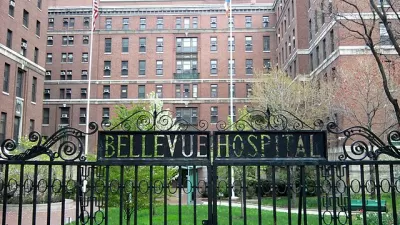With Campus Kilpatrick, Los Angeles County has made a serious investment in progressive design to support progressive programming.
At Metropolis Magazine, Thomas Musca and Emily Gardner profile a facility in Malibu they describe as “Los Angeles County’s $48 million wager on the future of youth incarceration.”
It’s Campus Kilpatrick, built on the site of the former Camp Vernon Kilpatrick, which was designed in the 1960s for the type of juvenile detention that the county would like to leave in the past.
The primary goal—and apparently, one accomplishment—of the new design is that someone incarcerated in it feels less incarcerated than they might in the average jail. It’s laid out like a small college campus, has a “cottage-style housing model,” and allows residents to wear their own clothes.
“In order to minimize the harsh visual impact of perimeter hurricane fencing, much of the campus is cordoned off by buildings. This is achieved by conjoining most of the eastern structures on site. The complex’s reception desk, waiting room, and ‘command post’ are consolidated in between administrative offices, staff housing, and the common room. While the command post has the entire campus in view, it is the anti-panopticon, ‘accountable’ to visitors by being completely visible from inside the waiting area.”
The architecture of correctional facilities is a relatively frequent topic in discussions of the ethic of design. Two years ago the AIA recently considered—then rejected—a petition that would have mandated censure for any member whose designs included areas devoted to solitary confinement or “death chambers.” A Dutch study on prison design found marked differences in the relationship between prisoners and staff, which deeply affected the experience of prisoners.
The idea behind Campus Kilpatrick, is that “state-of-the-art design supports the state-of-the-art programming.”
“This ethos informs a new ‘L.A. Model’ of youth detention that rejects a punitive, boot-camp incarceration style in favor of therapeutic support for its often traumatized occupants.”
A similar architectural approach to juvenile justice was recently finished in Marseille.
FULL STORY: Can the Design of L.A.’s New Juvenile Detention Facility Change the Future of Youth Incarceration?

Planetizen Federal Action Tracker
A weekly monitor of how Trump’s orders and actions are impacting planners and planning in America.

Map: Where Senate Republicans Want to Sell Your Public Lands
For public land advocates, the Senate Republicans’ proposal to sell millions of acres of public land in the West is “the biggest fight of their careers.”

Restaurant Patios Were a Pandemic Win — Why Were They so Hard to Keep?
Social distancing requirements and changes in travel patterns prompted cities to pilot new uses for street and sidewalk space. Then it got complicated.

Platform Pilsner: Vancouver Transit Agency Releases... a Beer?
TransLink will receive a portion of every sale of the four-pack.

Toronto Weighs Cheaper Transit, Parking Hikes for Major Events
Special event rates would take effect during large festivals, sports games and concerts to ‘discourage driving, manage congestion and free up space for transit.”

Berlin to Consider Car-Free Zone Larger Than Manhattan
The area bound by the 22-mile Ringbahn would still allow 12 uses of a private automobile per year per person, and several other exemptions.
Urban Design for Planners 1: Software Tools
This six-course series explores essential urban design concepts using open source software and equips planners with the tools they need to participate fully in the urban design process.
Planning for Universal Design
Learn the tools for implementing Universal Design in planning regulations.
Heyer Gruel & Associates PA
JM Goldson LLC
Custer County Colorado
City of Camden Redevelopment Agency
City of Astoria
Transportation Research & Education Center (TREC) at Portland State University
Camden Redevelopment Agency
City of Claremont
Municipality of Princeton (NJ)





























